|
The Nose Knows!
A Collies Online Interview with Marilyn Clayton, Woodruff Collies
1. What performance venues do you participate in? How long have you shown in each one?
• Obedience and Conformation since 1980;
• Some Tracking (off and on) since 1984;
• Herding and Agility since 2003;
• Rally since 2004;
• Draft/Carting since 2005; and
• Nose Work/Scent Detection since 2012.
2. What area of the country do you compete in? Is there any advantage or disadvantage to the area of the country in which you train?
I live near Victoria, British Columbia on Vancouver Island and compete largely in the Pacific Northwest (U.S. and Canada).
The biggest disadvantage to Island-living is having to take a ferry to train/trial/attend workshops on the mainland. It’s not only the ferry cost ($145 return) but also the restrictiveness of ferry schedules which usually means an extra night in a motel before (and often after) an event. The decline of the Canadian dollar means travel to the U.S. is 20 to 25 percent more, but . . . it’s a great time for Americans to come up to Canada and compete!!! We’d love to see you!
As for advantages, in some venues we have great local instructors; in other venues, travel to the mainland is required; and in yet other venues (e.g. nose work/scent detection) I work with a small group of like-minded friends with dogs at the same level and we stumble our way through the best we can . . . and we’re doing pretty well.
Also, in our area, we compete against some of the top competitors in Canada in Obedience, Agility and Herding, making us reach inside ourselves to do better . . . or realize we just don’t have what it takes (or the desire) to be at “the top” and are content to just do our best.
3. What brought you to showing collies in performance events? Tell us about your first time competing in a performance event.
Oh my, that was a long time ago! One day I went to a park with my first collie, Ceilidh, where there was an obedience fun match and thought, “my little girl can do that,” so I asked if I could attend the host club’s classes, which were held down the road from our house. Well, their representative, who I later discovered was also a CKC judge, looked me and my young little collie up and down and said “We’re full.” Naïvely I asked if I could go on a waiting list. The response was, “We don’t have a waiting list, but NOSA [another local dog club] will take you.” So, I joined NOSA; we bought a home nearby and I’ve been with them ever since as an instructor Executive member and now a Life Member.
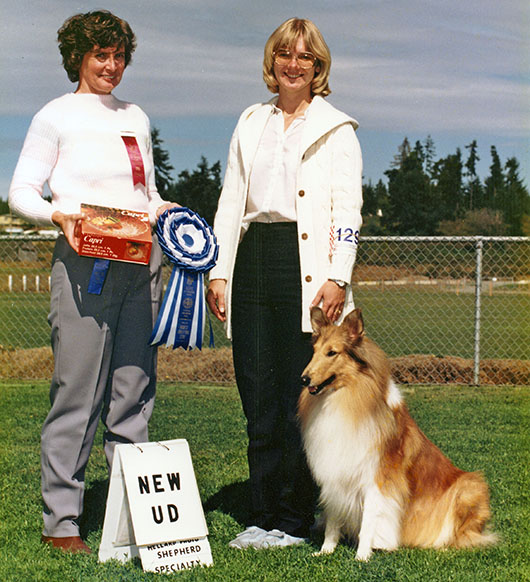 Ceilidh was Marilyn Clayton's first Collie -- Can. OTCh Glencoe Ceilidh’s Candy, Am.CD Ceilidh was Marilyn Clayton's first Collie -- Can. OTCh Glencoe Ceilidh’s Candy, Am.CD
At my first trial (Obedience), Ceilidh, who loved people and other dogs but was petrified of hot air registers, smiley faces drawn on the floor, etc., panicked at the start when the over-head fan came on. The judge kindly let me calm my dog before asking us to begin. Ceilidh kept an eye on her environment but did well enough to pass. As I took her out of the ring to the car, the judge, who’d told me their club “was full” cornered me outside and started going on and on how I had no right bringing that dog here to compete—that she would be a fear bitter; that I’d never put a CD on her . . . and on and on. To say I was upset would be an understatement! Ceilidh was a real sweetheart and even those fearful of dogs felt comfortable around her because of her calm and gentle nature. When I went into the ring to receive my qualifying score ribbon, our trial judge said, to everyone, what a good job I had done settling my dog and how well we had done. It was at that first trial that I decided, come hell or high water, we’d not only get our CD, but our UD—and we did—with High In Class wins along the way!!!!! And it darn near killed that nay-sayer judge to give us a couple of those High In Class wins. She even said once, under her breath so only I could hear, “you were not supposed to get this” as she presented one of our rosettes—the dog she was hoping would take the class went down on its long sit. It was really, really hard not to say anything, so I just grinned from ear to ear and said thank you!
4. Tell us how you learned and train to compete in performance events.
Oh my . . . how to answer this one . . . for most activities I learned by taking classes, private lessons and/or workshops, however in tracking and draft/carting I went out with friends who were doing that sport and followed their guidance. I also attended numerous workshops, seminars, demonstrations and lectures.
My dogs are my friends, constant companions and protectors as well as my partners in the various activities we choose to partake in. And we partake in those activities that each particular dog enjoys most.
I start very informally with fun training when my collies are babies—to build their confidence and start forming that bond between handler and dog; teaching them to love learning and “doing”; and to start foundation work that supports the activities I hope to participate in. I have to admit I’m a pretty lazy trainer so most of my training is incorporated into my day to day activities. For example, my obedience out-of-sight sits and downs are trained during my potty breaks on our walks. Heeling is thrown in for a minute or two during dog walks. I do a little here and there. But once the dog is old enough, I also take weekly classes from instructors who have successfully titled dogs themselves. I don’t believe in on-line certified instructors—I feel more confident with instructors who have hands-on experience preferably in my breed or in a variety of breeds. When training, I never drill my collies. If they do it correctly once, I move on. I use a lot of food in my training but also believe in the word “no” (without any emotional attachment) for serious infractions. Having a well-mannered dog, that’s a joy to live with, is a must for me regardless of how successful they become in the competition world. My dogs are my friends, constant companions and protectors as well as my partners in the various activities we choose to partake in. And we partake in those activities that each particular dog enjoys most.
5. How does this year fit it in with your journey in performance? Who are you currently showing/training in performance? Which venues?
Twelve-year-old Zephyr could not handle retirement. Seriously! I thought I was going to lose him. He had gone deaf very quickly; was really “down”; and moved slowly with his head almost dragging on the ground—he appeared unwell. I’d entered him in a Sporting Detection test earlier; couldn’t get a refund if I pulled; and I was going with Smoochie anyway so decided I’d put him in and if he just stood there, I’d thank the judge and excuse ourselves. Well, when we got to the start line and he saw all the containers, he pulled himself up onto his toes; that spark ignited in his eyes; and he ended up being one of three dogs (out of over 30 competitors) to pass all elements of his Sporting Detection test to earn his SD-Started title with ‘Special’ designation and Reserve High In Trial. He may no longer be fast, but he loves it; it gives him purpose; and he still gets the job done efficiently. Five months later he completed his Advanced SD title and we’re entered in our first Excellent level Sporting Detection tests next month. Many of our high achieving versatile collies are truly workaholics and don’t know what to do if they are not working. They need to feel involved and they need to continue being part of a team. Zephyr is OTCh, HChA, ATChC, AWCA-GVCh, Am.Ch & BISS Can.Ch & DCh. Signet’s “Way To Go!” Woodruff, Can. (DD, HAs, SDA, HX, AgX, AgXJ, RAE, CGN), Am.(CDX, HSAs, RE, NA, NAJ, CGC), CRXMCL, STDsd, HRDII, RLFII, HTADI, SilverAOM, ExStSilver, ExGBronze, ExJBronze, ExSnBronze, MSCDC, VBA, EAC, O-TN-E, ECC, TG-O, OJC, HP-O, WV-N, NVA, CRTX, SD-A, AOM, CCA-VX, 2010 CCA-MVC.
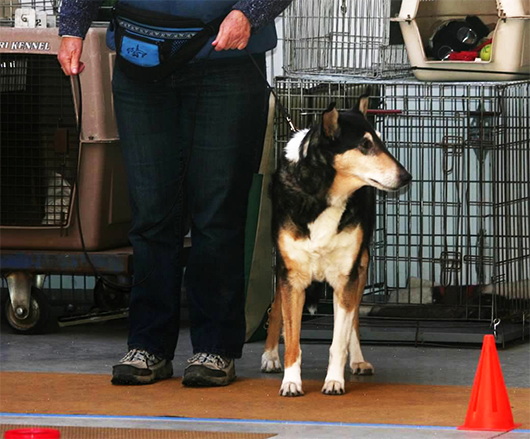 Zephyr at start line for Containers Zephyr at start line for Containers
Four-year-old Smoochie is titled in conformation, herding, obedience, agility and scent detection. In the past year she has earned her American Championship, 7 new CKC, 3 new NADAC and 3 new AAC Agility titles as well as her Sporting Detection Started and her AWCA VC and VCX titles. In the next few months we’ll be trialing in AAC agility (working toward her ATCHC), CKC obedience (hoping to complete her CDX), SDDA Sporting Detection (hoping to complete her Advanced title) and show in conformation in the coming Canadian Collie National (hoping to pick up some Canadian GCh points). Smoochie is Am./Can.Ch Sunnland’s Blame It On Rio, Can.(CD, HSs, HTd, AgXS, AgXJS, NP, CGN), Am.PT, OAC, NJC, TN-N, WV-N, TG-N, HP-N, MADC, AGDC, SD-S, AWCA-VCX.
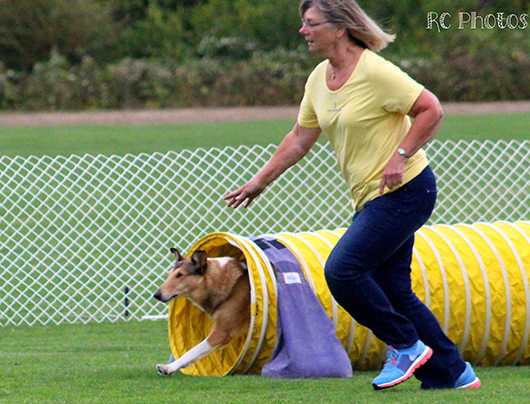
Marilyn and Smoochie in agility competition
6. Please let us know how things are going in your chosen venue (Scent
work) Please let us know what is involved in this venue. How does one get started?
Scent detection/nose work is more involved than a dog simply locating a specific scent/odour—dogs do that very easily. Rather, it’s about the dog relaying to the handler exactly where the source of that odor is so the handler can tell the judge its location. That communication between dog and handler is more difficult.
Some of the organizations doing scent work include the National Association of Canine Scent Work (NACSW); its Canadian counterpart is the Sporting Detection Dog Association (SDDA); the United Kennel Club; and more recently the ABC Games out of Washington State. The odors used, the rules and regulations and the set up are slightly different for each organization but the premise is the same—find the hidden odors in the allotted time.
The odor sources are Q-tips that have been cut in half and placed in jars with a few drops of a specific essential oil. Each hide usually includes two scented Q-tips placed in some type of container with holes in it or some type of tube so the odor can escape through the open ends. The container or tube is then hidden so neither the dog nor the handler can see it.
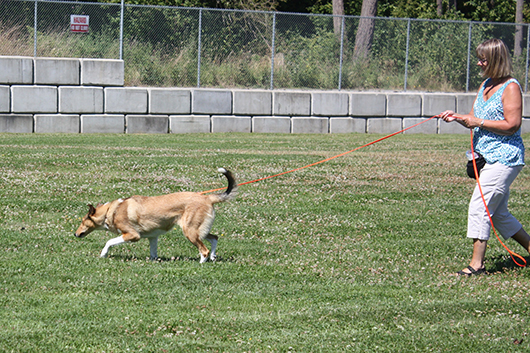
Smoochie - exterior search - hunting . . .
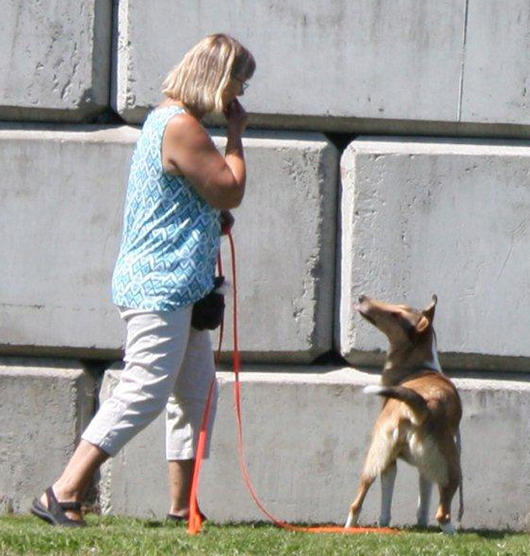 Smoochie - exterior search - found it! Smoochie - exterior search - found it!
There are typically three levels of titles: Started, Advanced and Excellent (or level 1, 2 and 3), although NACSW also has element specialty titles for each element (Container, Interior, Exterior, Vehicle) at each level (Level 1,2,3).
Scent detection is the ideal activity for older, disabled, recuperating and reactive dogs as well as the young and fit (that goes for the human side of the equation too – except for the reactive part I suppose).
There are four types of searches (or elements):
(1) Container searches, at the novice level, consist of one hide of one specific odor hidden in one of a number of uniform cardboard or plastic boxes [depending upon the organization], however once you get to Excellent/Level 3, there are three hides with a possibility of three different odors along with at least two distractors (can be food or toys) in luggage, purses, backpacks and other such containers.
(2) Indoor searches start with one specific odor in one room at the novice level and work up to three hides with a possibility of three different odors in three rooms, including one room which does not contain any odor—so you have to understand when your dog hasn’t found the hide vs when there isn’t a hide in the room to find. Indoor searches can be in school rooms (complete with old sandwiches hidden in desks), to offices, warehouses, bathrooms, in fact any type of indoor room.
(3) Exterior searches are anywhere outdoors—in parking lots, grassy areas, forests, on decks, between buildings—any outdoor area deemed safe. Again, at the novice level there is one hide of one odor and that increases to three hides and the possibility of three odors at the most advanced level.
(4) For vehicle searches only the outside of the vehicle is used. As you graduate from the novice to the most advanced levels, the number of vehicles to be searched increases; the number of hides increases; the possible number of odors increases; the placement of the hides becomes more difficult; and the configuration of vehicles can change. Any type of vehicle can be used from a motorcycle to a smart car; to a tractor; to a semi-trailer truck; to a hay wagon—in fact, any type of vehicle can be used—more to confuse and panic the handler, who "sees" everything. To a dog, it’s just a search for a specific scent and it doesn’t matter what the vehicles look like.
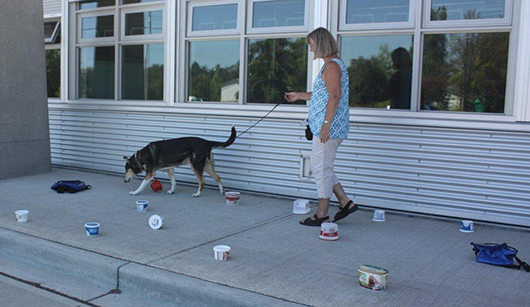 Zephyr practicing a container search Zephyr practicing a container search
To be successful, a handler must learn to trust and follow his dog . . . and not think too much. One must also take into account how scent drifts, swirls and pools under different circumstances; how a dog reacts when it has found scent vs when it is working a scent cone vs when it has found the source of that scent; how a dog communicates the exact location of the source of the scent to the handler; and how to help your dog without getting in its way and/or hindering it’s hunt. It’s not nearly as easy as it sounds and you can lose points simply for poor leash handling.
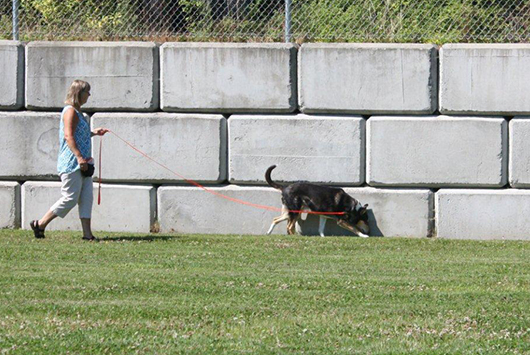 Zephyr Exterior search - hunting . . . Zephyr Exterior search - hunting . . .
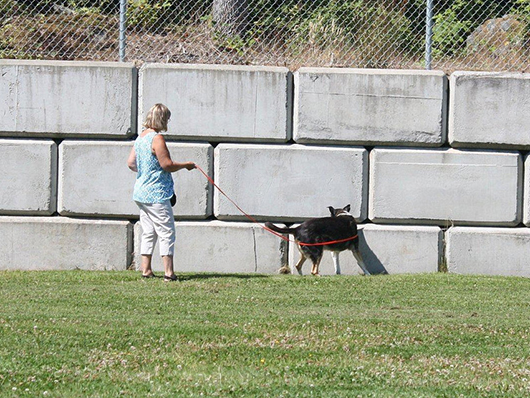 Zephyr Exterior search - found it! Zephyr Exterior search - found it!
Scent detection is the ideal activity for older, disabled, recuperating and reactive dogs as well as the young and fit (that goes for the human side of the equation too – except for the reactive part I suppose). One thing I noticed trialing Zephyr in our Advanced searches is that he has learned to conserve energy. While young dogs start working as soon as they cross the start line, Zephyr will work briefly at the start line (to see if he catches any of the target odors) and will either follow that scent to source or, if he did not pick up any scent at the start line, he will wander the area until he hits upon a scent cone and then he starts working it until he locates the source. At first, when he was wandering the search area, I thought he was tired and didn’t want to do another search. But, what I learned was that it is simply his way of conserving energy. Our experienced dogs have a lot of tricks up their sleeve.
A short, but true, story about my last Sporting Detection trial with Zephyr. Because Zeph is deaf, I bend a lot to look into his face, speak loudly, and make sweeping arm movements (hand signals)—it’s our way of communicating and it works, but it never occurred to me what that must look like to people who don’t know this detail about him. When we received our Exterior test sheets, the judges had docked points for him being distracted and had written “m/c”. When I asked what that meant, he told me my dog was distracted when the motorcycle went by . . . and out of my mouth (before I had a chance to think) was “He’s deaf—he doesn’t hear much of anything.” At the judge’s dinner, the judge casually leaned over to me and told me I should let judges know my dog is deaf. When I asked why, I could tell he didn’t know quite how to say it but he said something to the effect that after our first element he was wondering if he should get someone to help me out of the building. My response was, “You thought I was mentally handicapped?”. His response was “Well your dog looked OK.” We all had a good laugh over that but in retrospect I can see where he was coming from, so, if you have a handicapped dog, I suggest you let he judge know ahead of time what that handicap is.
I love owning beautiful Champion Collies, but it is the performance activities that I truly love – that bond between handler and dog that is built over the years and that is based on mutual trust, respect and a love for whatever game(s) you have chosen to play is something very special.
Nose work is not a spectator sport. In fact, the only people allowed in the search area are the judge, timer, scribe, and often a videographer/photographer and the competitor. Generally, no one else is allowed to watch the tests.
I think the easiest way to start training for scent work is to find classes locally. If that’s not possible, there are some good on-line courses that can get you started. However, I would warn against taking lessons from anyone who teaches dogs to hunt for food without odor, especially since dogs must ignore food distractions at the higher levels. Volunteering at trials is also a great way to learn and it’s the only way to watch a test without being entered. And of course, take advantage of any workshops in your area.
7. What motivates you to keep showing and training in performance events?
Aw, an easy question with several reasons. (1) Friendships! Performance is a huge part of my social life—I’ve become friends with so many wonderful and supportive people across the continent as a result of it. (2) That sense of partnership between my dogs and me. It’s exciting to watch my dogs develop and grow—to become successful and accomplished. Some dogs just love to work and please and both of my present collies are like that. In order to bring out that attitude, one has to make training sessions and ring experiences happy, enjoyable, successful events. (3) Activities, such as agility, double as my physical fitness program.
Playing performance is a great way to know the true temperament and character of your dog—what its strengths and weaknesses are and of course it also keeps your dog in top physical condition. Most performance dogs I know have their own massage therapist and/or chiropractor and/or naturopath and/or osteopath etc. Not because they get injured, but to keep them in top physical shape so they do NOT injure themselves.
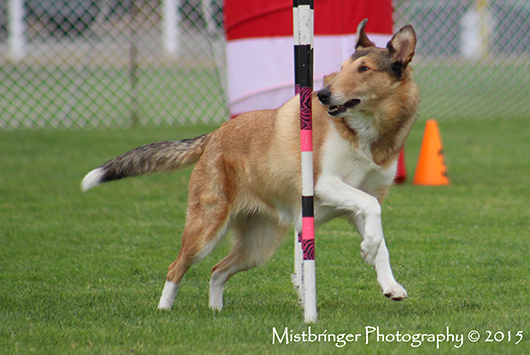 Smoochie in agility Smoochie in agility
I love owning beautiful Champion Collies, but it is the performance activities that I truly love—that bond between handler and dog that is built over the years and that is based on mutual trust, respect and a love for whatever game(s) you have chosen to play is something very special. If you haven’t tried performance, I highly recommend it!
^ Back to top
|